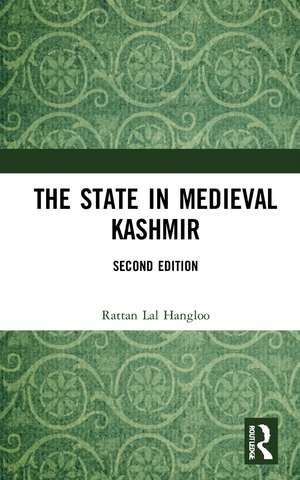The State in Medieval Kashmir
Autor Rattan Lal Hanglooen Limba Engleză Hardback – 2 iun 2022
The author has put together varied Sanskrit, Persian, and other sources on this region’s history and passed them through a theoretical lens to ensure a vivid focus and a long historical perspective. The book is a major contribution to medieval Indian history, particularly in Kashmir region.
Please note: Taylor & Francis does not sell or distribute the Hardback in India, Pakistan, Nepal, Bhutan, Bangladesh and Sri Lanka.
Preț: 996.17 lei
Preț vechi: 1214.84 lei
-18% Nou
Puncte Express: 1494
Preț estimativ în valută:
190.64€ • 197.90$ • 158.96£
190.64€ • 197.90$ • 158.96£
Carte tipărită la comandă
Livrare economică 22 martie-05 aprilie
Preluare comenzi: 021 569.72.76
Specificații
ISBN-13: 9781032292144
ISBN-10: 1032292148
Pagini: 202
Ilustrații: 4
Dimensiuni: 138 x 216 x 13 mm
Greutate: 0.34 kg
Ediția:2nd edition
Editura: Manohar
Colecția Routledge
ISBN-10: 1032292148
Pagini: 202
Ilustrații: 4
Dimensiuni: 138 x 216 x 13 mm
Greutate: 0.34 kg
Ediția:2nd edition
Editura: Manohar
Colecția Routledge
Public țintă
PostgraduateCuprins
Preface to the Revised Edition Preface to the First Edition Introduction 1. Historical Roots of State Formation in Pre-Sultanate Kashmir 2. Conversions to Islam and the Consolidation of a Social Base of Power in the Sultanate 3. The Sayyids, Sultans and the State: A Search for Legitimacy, 1339-1470 4. The Incorporation of the Sultanate into
the Mughal State 5. Conclusion
the Mughal State 5. Conclusion
Notă biografică
Rattan Lal Hangloo is Honorary Chancellor, Noble International University, Toronto. Hangloo was a Professor of History at the Hyderabad Central University and Vice Chancellor of Kalyani University, West Bengal, and Vice Chancellor of University of Allahabad. He has authored several books, primarily on the medieval Indian history.
Descriere
This book provides a comprehensive account of political processes and their varied foundations in medieval Kashmir. It examines some of the principal ways through which the region’s social and religious life interacted with the then, current political formations to produce peculiar structures of power and domination.
